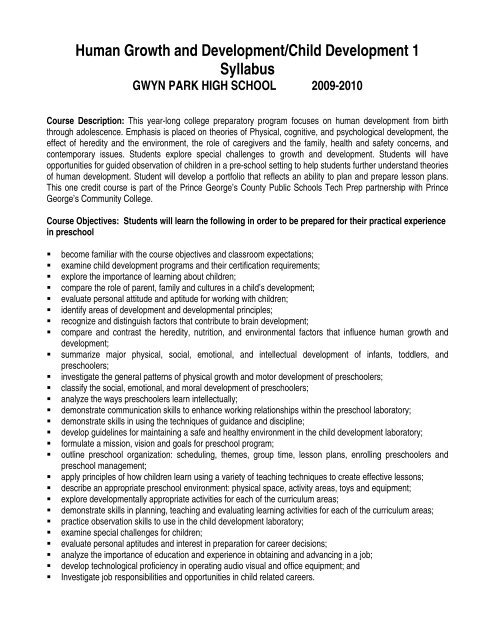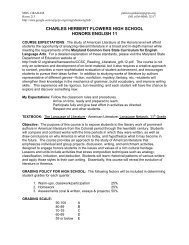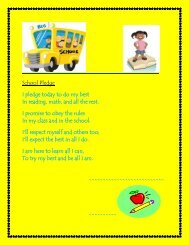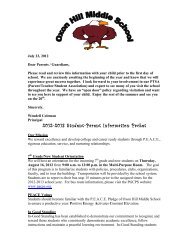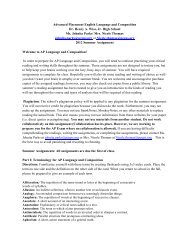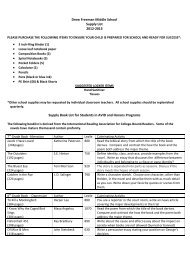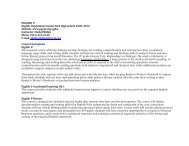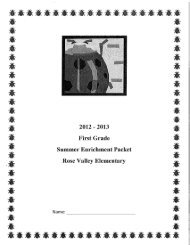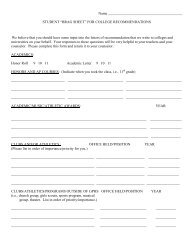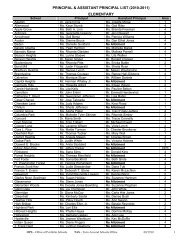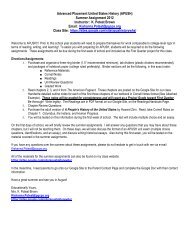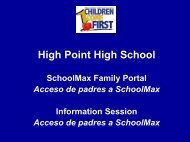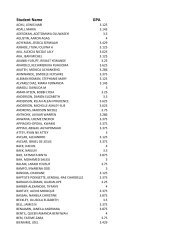Human Growth And Development/Child Development 1 Syllabus
Human Growth And Development/Child Development 1 Syllabus
Human Growth And Development/Child Development 1 Syllabus
Create successful ePaper yourself
Turn your PDF publications into a flip-book with our unique Google optimized e-Paper software.
<strong>Human</strong> <strong>Growth</strong> and <strong>Development</strong>/<strong>Child</strong> <strong>Development</strong> 1<br />
<strong>Syllabus</strong><br />
GWYN PARK HIGH SCHOOL 2009-2010<br />
Course Description: This year-long college preparatory program focuses on human development from birth<br />
through adolescence. Emphasis is placed on theories of Physical, cognitive, and psychological development, the<br />
effect of heredity and the environment, the role of caregivers and the family, health and safety concerns, and<br />
contemporary issues. Students explore special challenges to growth and development. Students will have<br />
opportunities for guided observation of children in a pre-school setting to help students further understand theories<br />
of human development. Student will develop a portfolio that reflects an ability to plan and prepare lesson plans.<br />
This one credit course is part of the Prince George’s County Public Schools Tech Prep partnership with Prince<br />
George’s Community College.<br />
Course Objectives: Students will learn the following in order to be prepared for their practical experience<br />
in preschool<br />
• become familiar with the course objectives and classroom expectations;<br />
• examine child development programs and their certification requirements;<br />
• explore the importance of learning about children;<br />
• compare the role of parent, family and cultures in a child’s development;<br />
• evaluate personal attitude and aptitude for working with children;<br />
• identify areas of development and developmental principles;<br />
• recognize and distinguish factors that contribute to brain development;<br />
• compare and contrast the heredity, nutrition, and environmental factors that influence human growth and<br />
development;<br />
• summarize major physical, social, emotional, and intellectual development of infants, toddlers, and<br />
preschoolers;<br />
• investigate the general patterns of physical growth and motor development of preschoolers;<br />
• classify the social, emotional, and moral development of preschoolers;<br />
• analyze the ways preschoolers learn intellectually;<br />
• demonstrate communication skills to enhance working relationships within the preschool laboratory;<br />
• demonstrate skills in using the techniques of guidance and discipline;<br />
• develop guidelines for maintaining a safe and healthy environment in the child development laboratory;<br />
• formulate a mission, vision and goals for preschool program;<br />
• outline preschool organization: scheduling, themes, group time, lesson plans, enrolling preschoolers and<br />
preschool management;<br />
• apply principles of how children learn using a variety of teaching techniques to create effective lessons;<br />
• describe an appropriate preschool environment: physical space, activity areas, toys and equipment;<br />
• explore developmentally appropriate activities for each of the curriculum areas;<br />
• demonstrate skills in planning, teaching and evaluating learning activities for each of the curriculum areas;<br />
• practice observation skills to use in the child development laboratory;<br />
• examine special challenges for children;<br />
• evaluate personal aptitudes and interest in preparation for career decisions;<br />
• analyze the importance of education and experience in obtaining and advancing in a job;<br />
• develop technological proficiency in operating audio visual and office equipment; and<br />
• Investigate job responsibilities and opportunities in child related careers.
Essentials for the Curriculum<br />
In order to fully implement the lessons included in this curriculum, the students must have access to the following<br />
equipment items:<br />
• Textbooks to be used in class and signed out as necessary:<br />
“Infants, <strong>Child</strong>ren, and Adolescents (5 th Edition) by Laura Berk<br />
“The Developing <strong>Child</strong>,” by Holly Brisbane (2006)<br />
• computer<br />
• printer<br />
• flash drive (Must have)<br />
• Lab fee 10/=<br />
• scanner, LCD projector and copier machine (provided for use in classroom)<br />
• digital camera (may be provided for use in classroom)<br />
Required Materials for Class Daily<br />
3 ring notebook and loose-leaf paper<br />
Black or dark blue ink pen<br />
Composition book<br />
Miscellaneous supplies needed for <strong>Child</strong> <strong>Development</strong> lesson plans<br />
25-30 clear sheet protectors for portfolio<br />
Long Term Projects (due quarterly)<br />
• Baby Book (Q1)<br />
• Baby Think It Over/ Reality Works (Q2)<br />
• Muppet and Puppet Show (Q3)<br />
• Summer Book for preschoolers (Q4)<br />
<strong>Child</strong> <strong>Growth</strong> and <strong>Development</strong>/Parenthood Education 1<br />
Course Outline and Pacing Guide<br />
Unit 1: Introduction (One Week, 1st quarter prior to opening preschool lab)<br />
• Become familiar with the course objectives and classroom expectations.<br />
• Examine child development programs and their certification requirements.<br />
Unit 2: <strong>Child</strong> <strong>Growth</strong> and <strong>Development</strong> (One to two weeks, 1 st quarter prior to opening preschool lab)<br />
• Explore the importance of learning about children.<br />
• Compare the role of parent, family and cultures in a child’s development.<br />
• Evaluate personal attitude and aptitude for working with children.<br />
• Identify areas of development and developmental principles.<br />
• Recognize and distinguish factors that contribute to brain development.<br />
• Compare and contrast the heredity, nutrition, and environmental factors that influence human growth and<br />
development.
• Summarize major physical, social, emotional, and intellectual development of infants, toddlers, and<br />
preschoolers.<br />
• Investigate the general patterns of physical growth and motor development of preschoolers.<br />
• Classify the social, emotional, and moral development of preschoolers.<br />
• Analyze the ways preschoolers learn intellectually.<br />
Unit 3: Interactions with and Guiding <strong>Child</strong>ren (One Week, prior to opening preschool lab)<br />
• Demonstrate communication skills to enhance working relationships within the preschool laboratory.<br />
• Demonstrate skills in using the techniques of guidance and discipline.<br />
Unit 4: Establishing and Maintaining a Safe and Healthy Environment (Two weeks, 1 st Qtr prior to opening<br />
preschool lab)<br />
• Develop guidelines for maintaining a safe and healthy environment in the child development laboratory.<br />
• Develop guidelines for planning and preparing nutritious meals and snacks for children.<br />
• Use of technology to explore the impact of the media on nutritional food choices for children.<br />
Unit 5: Curriculum and Organization (Four weeks, 1 st Qtr prior to and concurrent with preschool lab Qtrs 2-3)<br />
• Formulate a mission, vision and goals for preschool program.<br />
• Outline preschool organization: scheduling, themes, group time, lesson plans, enrolling preschoolers and<br />
preschool management.<br />
• Apply principles of how children learn using a variety of teaching techniques to create effective lessons.<br />
• Describe an appropriate preschool environment: physical space, activity areas, toys and equipment.<br />
• Explore developmentally appropriate activities for each of the curriculum areas.<br />
• Demonstrate skills in planning, teaching and evaluating learning activities for each of the curriculum<br />
areas.<br />
Unit 6: Observing and Recording Behavior (One week prior to and concurrent with preschool lab Qtrs 1-4))<br />
• Practice observation skills to use in the child development laboratory.<br />
• Summarize guidelines for observing young children in order to follow professional standards and ethics.<br />
Unit 7: Meeting Special Needs (Two weeks concurrent with preschool lab)<br />
• Examine special challenges for children.<br />
• Recognize the signs of child abuse.<br />
• Evaluate personal aptitudes and interests in preparation for career decisions.<br />
• Analyze the importance of education and experience in obtaining and advancing in a job.<br />
• Develop technological proficiency in operating audio visual and office equipment.<br />
• Investigate job responsibilities and opportunities in child related careers.<br />
Unit 8: Transition from School to Careers (Two weeks)<br />
• Evaluate personal aptitudes and interests in preparation for career decisions.<br />
• Analyze the importance of education and experience in obtaining and advancing in a job.<br />
• Develop technological proficiency in operating audio visual and office equipment.<br />
• Investigate job responsibilities and opportunities in child related careers.
Grading Policy<br />
Class participation (individual and group) is an integral part of this course. Students are expected to<br />
successfully complete and turn in every assignment when given. It is important that all assignments be<br />
completed and submitted on time. Late assignments will receive a reduced or no grade at all. Make<br />
up work for excused absences must be obtained within 48 HOURS by the student and completed by<br />
the number of days the student was absent from class. Equivalent work will be given if the missed<br />
work cannot be duplicated. IT IS THE STUDENT’S RESPONSIBILITY TO MAKE<br />
ARRANGEMENTS FOR MAKE-UP WORK. The student with an unexcused absence or tardy will<br />
receive a zero for the work missed, as well as the student who fails to make up work within the<br />
required period of time.<br />
Grading is based upon the following:<br />
40% Class work (daily warm-ups, class assignments and work habits)<br />
50% Labs, Lesson Plans, Observations, Assessments (includes quizzes,<br />
exams and portfolio)<br />
10% Homework<br />
Grading scale is as follows:<br />
A 90-100%<br />
B 80-89%<br />
C 70-79%<br />
D 60-69%<br />
E 59% and below<br />
Work habits include being on time to class (in seat when the tardy bell rings) and on task, meeting the<br />
appropriate dress code with ID visibly worn, notebook, paper, pen, and any other required materials, as<br />
well as adherence to school and class rules.<br />
Grades should be monitored by students and parents through SchoolMax.com<br />
All students are required to pass a safety test with a minimum grade of 70% in order to participate in<br />
preschool laboratory activities.<br />
Important Policies<br />
Attendance:<br />
Prompt, regular attendance is imperative for success in this course. The absentee policy will be<br />
handled according to Prince Georges County Public Schools requirements.<br />
Note: Students desiring to take the <strong>Child</strong> <strong>Growth</strong> and <strong>Development</strong>/Parenthood Education 2 intern<br />
course next year must meet the following prerequisites: receive a final grade of at least a “C” in<br />
<strong>Child</strong>/<strong>Human</strong> <strong>Growth</strong> and <strong>Development</strong>, successfully complete the required portfolio of 6 lesson plans<br />
in 6 different curriculum areas, have good attendance, and have demonstrated being a positive role<br />
model for young children in our preschool program.
Class Rules<br />
1. Be seated in your assigned seat prepared to work before the bell rings and remain seated<br />
until dismissed by teacher.<br />
2. Bring required materials to class everyday (i.e., notebook, ink pen ,etc)<br />
3. Be respectful of others and their property. Refrain from using obscene or offensive<br />
language.<br />
4. Take care of personal needs before coming to class.<br />
5. Eating and drinking must be done outside the class room in the designated area.<br />
6. Turn assignments in on time.<br />
7. Follow directions the first time they are given.<br />
----------------------------------------------------------------------------------------------------------------------------<br />
I have read the above syllabus for <strong>Child</strong> <strong>Growth</strong> and <strong>Development</strong>/Parenthood Education 1 and<br />
understand the content and requirements.<br />
Principal Signature<br />
_________________________________________Date ______________<br />
Student Name (Please print) ________________________________________________________<br />
Student Signature: ______________________________________________ Date: _____________<br />
Parent/Guardian Signature: _______________________________________ Date: ______________


